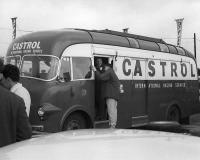Ural » 379P / 395P
In the early 1970s, Ural developed innovative designed secret prototypes of army amphibian trucks with a carrying capacity of 4 and 7 tonnes, respectively, based on Ural 379A and Ural-395. Exterior design was very similar to a conventional trucks, but the amphibious versions got designations "Ural-379P" and "Ural-395P". This was an attempt in converting a conventional army truck to an amphibious vehicle, which could be used on water with minimal rework of the chassis after mounted of two three-bladed propellers. They were driven by a power take-off. Ural 379P and 395 could reach speeds on the water up to 4-6 kph. There was also a new all-metal flatbed body (body-bearing monocoque) with high steel sides and a sealed rear side.
Lightweight plastic cabins of conventional models were replaced by more durable and roomy sealed 2-place all-metal cabins with two pieced flat windshield. Polyurethane foam that covers the cabin, bottom of the chassis and flatbed body, was used as a sealant. To further increase the flotation the design included special removable floats made of polyurethane. The prototypes also were equipped with winches and tire pressure control systems.
Prototypes of amphibious trucks were tested in 1972-1973. They were equipped with two fuel tanks, spotlights, special lighting equipment and high air intakes behind the cab. We don't know exact results of those tests, but almost obvious the prototypes were too heavy and unstable afloat with poor controllability and maneuverability on water.




